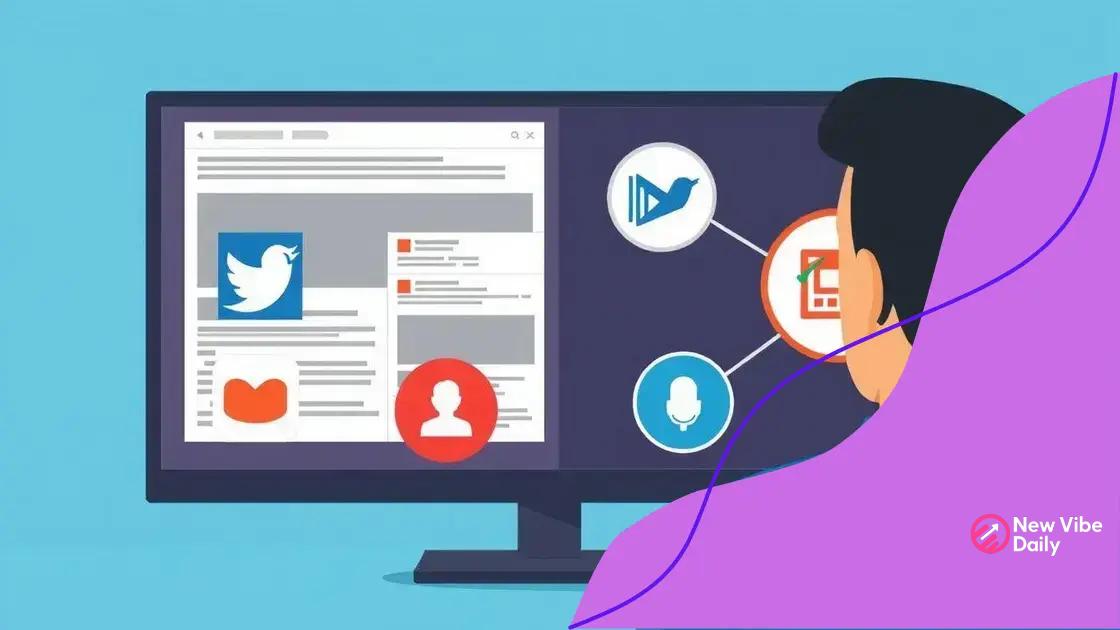Analyzing misinformation spread: How to combat it

Analyzing misinformation spread involves understanding how false information disseminates, recognizing its sources, and employing critical thinking and fact-checking techniques to combat its influence on public perception.
Analyzing misinformation spread has become essential in our digital age. With social media amplifying false narratives, how can we discern fact from fiction? Let’s explore effective strategies to tackle this issue.
Understanding the nature of misinformation
Understanding the nature of misinformation is critical for navigating today’s information landscape. Misinformation refers to false or misleading information that spreads quickly, often through social media and other platforms. This phenomenon is a concern for society, as it can influence public opinion and behavior.
Characteristics of Misinformation
Misinformation often exhibits certain characteristics that can help us identify it. Here are some key traits:
- It can be unintentional, arising from misunderstanding.
- It is usually sensational or emotionally charged, attracting attention.
- It spreads rapidly through shares and retweets.
- It may appear credible due to the source sharing it.
Recognizing these characteristics can empower us to question the information we encounter. For instance, when we read a shocking headline, it’s essential to verify the claims made in the article before reacting.
How Misinformation Spreads
The way misinformation spreads can vary. Its paths often include:
- Social media platforms where users share content.
- News articles that sensationalize stories.
- Word of mouth in communities.
These channels create a fertile ground for misinformation to grow. Each share and comment adds to its reach, making it even more critical for users to critically assess the information they consume.
By understanding how misinformation works and recognizing the signs, we can become more informed consumers of news. This awareness helps us combat the negative impacts of spreading false information in our communities.
Consequences of misinformation spread
The consequences of misinformation spread are far-reaching and affect individuals and society. One major impact is the erosion of trust in reliable information sources. When people are exposed to persistent falsehoods, they may begin to doubt everything they read, creating a skeptical environment.
Impact on Public Opinion
Misinformation can significantly shape public opinion. This manipulation often occurs during critical events, like elections or health crises. Individuals may make decisions based on false information, leading to negative consequences.
- Influencing voting behavior and election outcomes.
- Creating panic during public health emergencies.
- Shaping perceptions of social issues and policies.
These effects can create divisions within communities, leading to conflicts based on misinformation. The spread of false narratives can polarize opinions and breed hostility, making constructive discussions challenging.
Effects on Mental Health
The emotional toll of misinformation cannot be underestimated. Constant exposure to alarming news can lead to increased anxiety and stress. This is particularly true in rapidly changing situations, such as during a pandemic or political unrest. People might feel overwhelmed and confused, struggling to determine what information is trustworthy.
In this information-saturated environment, it is crucial to practice critical thinking. By questioning the information we consume and sharing reliable sources, we can help mitigate the adverse effects of misinformation spread. This allows for a healthier discourse and a more informed society.
Identifying sources of misinformation

Identifying sources of misinformation is a crucial skill in today’s information age. Not all information is accurate, and understanding where it comes from can help us distinguish fact from fiction. Misinformation can arise from various channels, and being aware of these sources can empower us to critically evaluate the content we encounter.
Types of Misinformation Sources
There are several common types of sources that often spread misinformation. Recognizing them can be the first step in combating false narratives:
- Social Media: Platforms like Facebook and Twitter can quickly amplify false information through shares and retweets.
- Fake News Websites: These sites often mimic legitimate news outlets but produce sensational and misleading content.
- Influencers: Some social media personalities share unverified claims, leading their followers to believe inaccurate information.
- Official-looking Documents: Sometimes, false information is packaged as official reports or studies to give it an air of credibility.
Each of these sources can play a significant role in the spread of misinformation. By being aware of where information originates, we can better filter what we choose to believe and share.
Verifying Information
When we encounter a piece of information, it’s important to verify its source. Ask yourself:
- Who created the content?
- Is there evidence to support the claims being made?
- Are reputable sources reporting the same information?
Using reliable fact-checking websites can also help us confirm the accuracy of information. By adopting a skeptical and inquisitive mindset, we can significantly reduce the impact of misinformation in our lives.
Techniques to combat misinformation
Techniques to combat misinformation are essential in today’s digital world. As false information spreads rapidly, knowing how to address it becomes crucial. Various strategies can help individuals and communities counteract the effects of misinformation, ensuring a more informed public.
Critical Thinking Skills
One of the most effective techniques is enhancing our critical thinking skills. This involves:
- Questioning the information we encounter.
- Seeking evidence before accepting claims.
- Analyzing the credibility of sources.
By actively engaging with information, we can better differentiate between factual and misleading content.
Fact-Checking Resources
Using reliable fact-checking resources is another practical method to combat misinformation. Websites such as Snopes, FactCheck.org, and PolitiFact provide valuable tools to verify the accuracy of claims. They analyze the context and provide well-researched conclusions about various reports. Incorporating these resources into our daily information consumption can help reduce the spread of false narratives.
Additionally, educating others on how to access and use these fact-checking sites creates a ripple effect, raising awareness within communities.
Promoting Media Literacy
Promoting media literacy is a powerful technique in the fight against misinformation. This educational approach informs people about how media works and how information is created. Teaching skills such as:
- Recognizing bias in news stories.
- Understanding propaganda techniques.
- Identifying misleading headlines and visuals.
Empowers individuals to engage critically with media content. By fostering these skills from a young age, we can build a society that is resilient to misinformation.
Implementing these techniques is vital for creating a more informed public that can discern fact from fiction. By developing our critical thinking abilities, utilizing fact-checking resources, and promoting media literacy, we can significantly reduce the adverse impacts of misinformation.
The role of social media in misinformation
The role of social media in misinformation spread is significant and complex. Social media platforms are now primary sources of news for many people. However, they also serve as avenues for the rapid dissemination of false information. Understanding how these platforms facilitate misinformation is crucial for users.
Speed of Information Sharing
Social media allows information to spread incredibly fast. A single post can go viral within minutes, reaching thousands or even millions of users. This rapid sharing makes it easy for misinformation to gain traction. Often, people share content without verifying its accuracy, contributing to the spread of false claims.
Algorithms and Engagement
Most social media platforms use algorithms that prioritize content based on user engagement. Content that gets more likes, shares, and comments is more likely to be seen. Unfortunately, sensational and misleading information tends to attract more engagement. This results in misinformation being amplified in users’ feeds, overshadowing legitimate news.
Many users may not realize that the information they are consuming and sharing is, in fact, misleading. It becomes crucial for them to recognize how social media influences their perceptions and beliefs.
Combating Misinformation
To effectively combat misinformation on social media, users should consider the following strategies:
- Verify information by checking multiple credible sources.
- Be cautious about sharing content without confirming its legitimacy.
- Use fact-checking services before spreading information.
By adopting these practices, users can help reduce the influence of misinformation on social media. They play a vital role in fostering a healthier information environment by being more discerning about the content they share and consume.
Combatting misinformation is a shared responsibility that requires awareness and effort from everyone. By understanding the role of social media, practicing critical thinking, and using reliable fact-checking resources, we can help limit the spread of false information. Encouraging media literacy and being thoughtful about the content we share can create a more informed and connected community. Together, we can make a difference and promote a healthier information environment.
FAQ – Frequently Asked Questions about Misinformation
What is misinformation?
Misinformation refers to false or misleading information that spreads, often unintentionally, and can influence public opinion and behavior.
How does social media contribute to the spread of misinformation?
Social media allows for the rapid sharing of information, making it easy for false claims to go viral before they can be verified.
What techniques can I use to identify misinformation?
You can verify sources, check for evidence, and use fact-checking websites to determine the accuracy of the information.
Why is media literacy important in combating misinformation?
Media literacy teaches people how to critically analyze information, helping them differentiate between reliable content and misleading narratives.






